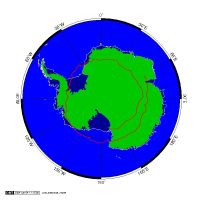|
As TIGER
finished about one-third of its second revolution, concerns
about the possibility of the payload going to higher latitudes over the
ocean caused NSBF to begin looking at where a good place would be to
cut the payload loose from the balloon. Although we would have
liked
to have completed a full second revolution, the concerns NSBF was
having were real to us too and we agreed that cutting the payload down
before the balloon spiraled out of control over the ocean was a good
idea. Since the TRACER payload suffered a rather severe fire at
float,
it has recently become apparent to NSBF that their SIP may not be
reuseable. Losing yet another SIP on the TIGER / ANITA / ARIA
payload
was not a very pleasant option.
|
 |
|
And so at about 11:20 PM on January 4 (4:20
AM CST January 4), NSBF began the process of valving down the
balloon. By
doing this, they release helium from the balloon so that it will drop
to a lower altitude before they give the command to explode the bolt
that keeps the payload and the parachute attached to the balloon.
The balloon was at an altitude of around 135,000 feet when the valving
began. The payload was cut loose at about 3:23 AM January 5 (8:23
AM CST January 4) at an altitude of around 110,000 feet. The
payload took about 37 minutes to hit the ground. The parachute
normally starts to slow the payload down at around 85,000 feet (when
the air gets thick enough to inflate it).
In the end, we had an extremely successful flight,
with about 17 days of useable data. Plans for recovery of the
payload will be commencing almost immediately. It landed at a
latitude of -71° 45.6' and a longitude of 58° 45.6' near
the Australian Mawson Base. Plans for recovery of the payload
will be commencing almost immediately and it will most likely be a
collaborative effort between NSF support and the Australians. The
ANITA hard drive and the NSBF SIP will most likely be recovered this
season but it is likely that the rest of the payload will winter over
and be retrieved next season.
In the end, we had an extremely successful flight,
with about 17 days of good data. It wasn't what anyone would call
an easy flight, definitely more challenging than our last flight in
2001 - 2002. But with the help of our tremendous collaboration at
Washington University, the California Institute of Technology, NASA's
Goddard Space Flight Center and the University of Minnesota, we will
come even closer to discovering the elusive origin of galactic cosmic
rays.
|



